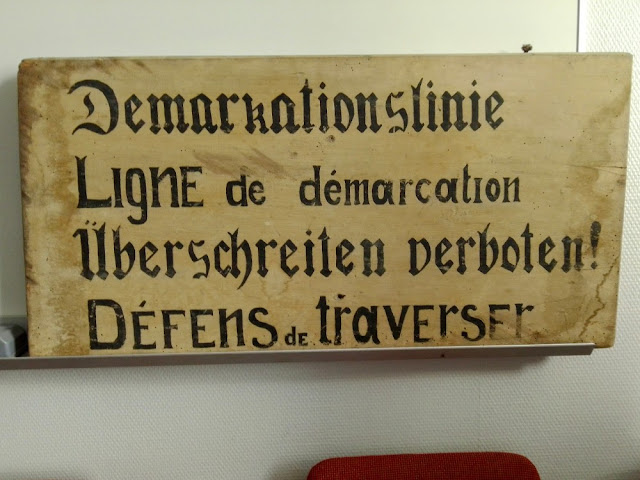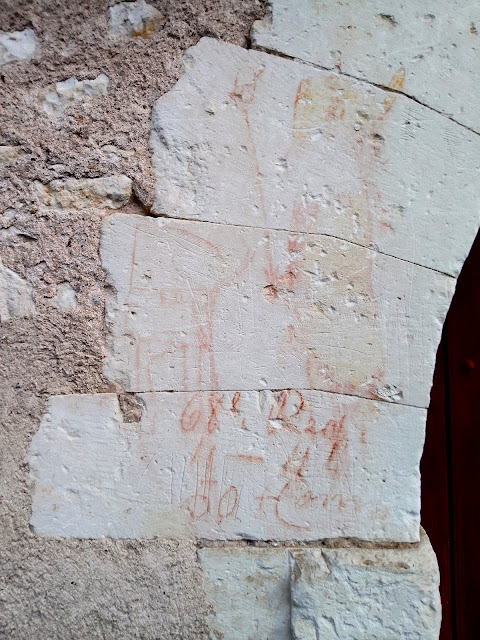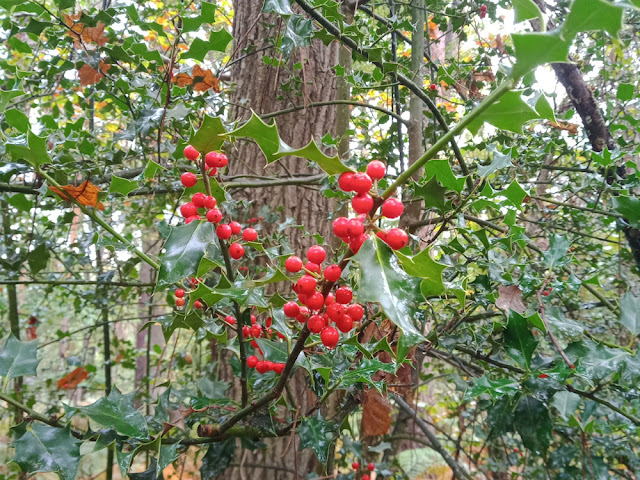Thursday, 31 October 2024
Awaydays Blog Post 2
Tuesday, 29 October 2024
Monday, 28 October 2024
A Visit From Family
Saturday, 26 October 2024
A Bit Sobering
Friday, 25 October 2024
A Domestic Day
Thursday, 24 October 2024
A Lovely Day
Wednesday, 23 October 2024
The Dufy Trails
Tuesday, 22 October 2024
Another Mystery
Saturday, 19 October 2024
Further Afield
Friday, 18 October 2024
The Boule d'Or
Thursday, 17 October 2024
Bonus!!
Wednesday, 16 October 2024
Walking From le Grand Pressigny
On Monday 14 October both Simon and I joined the Phoenix en Claise walking group for a 5.75 kilometre walk from le Grand Pressigny. It was remarkably warm, in the low 20s celsius, and took an hour and a half. Simon did 3 kilometres and then peeled off to return to the car. He's not quite fit enough at the moment for the full walk and was worried he would conk out.
A friend greets us from her window.
A village house being restored.
The Chateau du Grand Pressigny.
The ruined keep of the Chateau du Grand Pressigny.
The Nymphaeum, a spring fed pool that served as a relaxation station for 17th century aristocratic women.
An Ivy Bee Colletes hederae (Fr. Collète du lierre) doing what it does best -- feeding on ivy flowers.
Yellow Stainers Agaricus xanthodermus (Fr. Agaric jaunissant), growing in typical fashion, through a hedgerow.
Lizard Orchid Himantoglossum hircinum (Fr. Orchis bouc) leaf rosettes.
Big Sheath Mushroom Volvopluteus gloiocephalus (Fr. Volvaire gluante).
View looking down the Claise Valley.
Tuesday, 15 October 2024
The Miseries and Misfortunes of War
In the Chateau of Azay le Rideau there is a 17th century piece of furniture in ebonised wood, with engraved ivory panel drawer fronts. When you look closely at the astonishingly minutely detailed ivory panels you realise that each of them depicts an horrific scene of torture, death and cruelty. At the centre top of the piece is the inscription 'Les Misères et les Malheurs de la Guerre'.
Plate 3: The Battle. Considered to be the least successful of these etchings.
The middle of the print depicts a cavalry charge. The foreground is littered with dead men and horses. The infantry can be seen engaging in the distance to the right.
The drawer fronts are versions of a famous series of etchings by Jacques Callot, created in 1633. They are reknowned as a piece of anti-war protest, and tell the story of ordinary soldiers from recruitment through fighting in battles and then becoming out of control as they ravage civilians. Finally they are arrested and executed. Each etching has an explanatory text underneath and the series can be considered the ancestor of French graphic stories (bandes dessinées).
Plate 5: Pillaging a farmhouse.
Inside a vast and well provisioned house the soldiers indulge in every kind of excess.
The etchings are Callot's reaction to the Thirty Years War, when Cardinal Richelieu sent troops in to Lorraine, at that time an independent duchy. Callot lived in the provincial capital Nancy and witnessed the destruction and devastation to civilians caused by the soldiers as they participated in the annexation of the territory for France. He produced the etchings half way through the conflict, having lived through 15 years of war in his home province. The original plates for these etchings are housed in the museum in Nancy. There are 18 illustrations in the original series, although only six are represented on the piece of furniture at Azay le Rideau.
Callot was a master of the technique of multiple 'bitings' of acid, with sections 'stopped out' so that there is gradation in the strength of line, and scenes in the distance are lighter than those in the foreground.
This series was influenced by earlier French, Italian and Flemish works, and in turn influenced later engravers such as Hogarth and Goya.
Plate 14: Breaking on the Wheel.
The instrument of torture is standing in the middle of a square crowded with soldiers and civilians. A condemned man is already tied to the wheel and attended by a priest. The executioner is about to strike. Another condemned man, escorted by a monk, is visible on the left of the print.
Callot's paternal grandfather married a grand-niece of Joan of Arc, and was enobled for loyal service to the Duke of Lorraine. His family did not encourage the young Jacques passion for drawing, and at the age of 12 he ran away to Rome to train in an Italian workshop. Unfortunately, once there he was recognised by merchants from Nancy who were friends of his family, and they packed him off back home. His father insisted he go back to school and concentrate on academic subjects, but by the age of 14 he had absconded once again. This time he was found in Turin by his older brother and brought home. Finally his father aquiesced and Jacques was apprenticed to a goldsmith and engraver who ran the mint for the Duke of Lorraine. Jacques had already been hanging around in his workshop, but ultimately he did not complete his four year apprenticeship.
Plate 17: The Peasants Fight Back.
Soldiers returning from pillaging have been spotted at the edge of a forest by peasants who slaughter them, rob them, and take revenge on them for the evils they have suffered.
At the age of 16 he was sent, with his father's blessing, to study engraving in Italy, albeit with a French workshop master in Rome. There he rejoined his lifelong friend and collaborative partner, Israël Henriet. Then he went to work for the Medicis in Florence, before returning to Lorraine and marrying. After a brief sojourn in the Low Countries working on a commission from the Infanta, who governed this territory on behalf of her father, Phillip II of Spain, he went to Paris, but the King, Louis XIII, could not tempt him to stay. He died of stomach cancer aged just 42, leaving an impressive body of work which includes about 1500 etchings, and having made several significant technical innovations to the art form (such as using hard luthiers varnish on the copper plates rather than wax, which meant that the working surface was less prone to damage).
Glossary of terms:
Etching -- a printmaking technique where a metal plate is coated in wax, then a needle used to draw a design. Acid is used to eat away the metal which has been exposed, thus creating a printing plate. The acid is said to 'bite' the metal. Etching tools are pulled by the hand working them, so is more like drawing. Etching is quicker than engraving and Callot's preferred technique.
Engraving -- a technique whereby a hard surface such as metal or glass has a design cut into it with a burin. Engraving can be used as a decorative technique in its own right or to create printing plates. Engraving tools are pushed by the hand working them, so is more like carving. Engraving is slower than etching.
Monday, 14 October 2024
What have Susan and Simon Been Doing?
Friday, 11 October 2024
Who Were the 68th?
Thursday, 10 October 2024
Look Out For Travellers Joy in the Touraine Loire Valley
Travellers Joy Clematis vitalba (Fr. Clématite des haies).
Wednesday, 9 October 2024
Alert
Tuesday, 8 October 2024
Look Out for Holly in the Touraine Loire Valley
Holly Ilex aquifolium (Fr. Houx).
Monday, 7 October 2024
La Vie en Rose
The town hall in le Grand Pressigny, decorated for Breast Cancer Awareness Month.
October is Breast Cancer Awareness month in France, as it is in many countries. In France it is known as Octobre Rose. Here in the Touraine virtually every village shop and town hall has put up posters and decorated their windows in pink. Fundraising events for the Ligue Contre le Cancer are organised all over.
Tineke and other volunteers leading the pre-walk warm up.
We participated in the walk organised in le Grand Pressigny. You could choose to walk 1, 3, 6 or 13 kilometres. The start was staggered, and everyone came together again at the four banal (medieval community bread oven) which had been fired up to provide complimentary fouaces (pocket breads) to the walkers. Delicious stuffed with rillettes (pork paste)!
Walkers picking up their fouaces.
Simon and I did the 3 kilometre walk (just in case he conked out on the 6 kilometre walk, which was what most of our friends did). We couldn't stay for the lunch afterwards because we had to get to the pharmacy back in Preuilly to pick up Simon's new medication.
Walkers milling about at the finish while they wait for lunch.
It was a well organised event, well supported by all ages in the community, the weather was good, and I hope they made lots of money from donations and the sale of merch for the Ligue Contre le Cancer.




















































